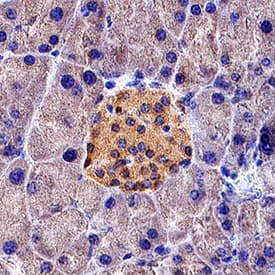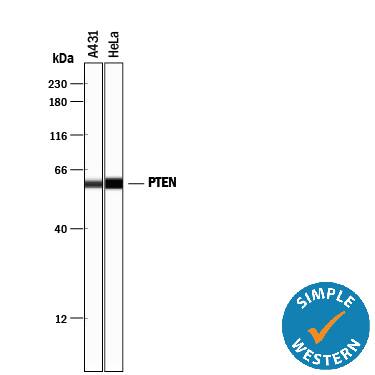Human/Mouse/Rat PTEN Antibody
R&D Systems, part of Bio-Techne | Catalog # AF847


Key Product Details
Validated by
Species Reactivity
Validated:
Cited:
Applications
Validated:
Cited:
Label
Antibody Source
Product Specifications
Immunogen
Ser385-Val403
Accession # P60484
Specificity
Clonality
Host
Isotype
Scientific Data Images for Human/Mouse/Rat PTEN Antibody
Detection of Human/Mouse/Rat PTEN by Western Blot.
Western blot shows lysates of mouse and rat brain tissue, A431 human epithelial carcinoma cell line, and MRC-5 human embryonic lung fibroblast cell line. PVDF membrane was probed with 0.1 µg/mL Rabbit Anti-Human/Mouse/Rat PTEN Antigen Affinity-purified Polyclonal Antibody (Catalog # AF847) followed by HRP-conjugated Anti-Rabbit IgG Secondary Antibody (Catalog # HAF008). For additional reference, recombinant human PTEN (5 ng) was included. A specific band for PTEN was detected at approximately 54 kDa (as indicated). This experiment was conducted under reducing conditions and using Immunoblot Buffer Group 4.PTEN in Human Pancreas.
PTEN was detected in immersion fixed paraffin-embedded sections of human pancreas using Rabbit Anti-Human/Mouse/Rat PTEN Antigen Affinity-purified Polyclonal Antibody (Catalog # AF847) at 3 µg/mL for 1 hour at room temperature followed by incubation with the Anti-Rabbit IgG VisUCyte™ HRP Polymer Antibody (VC003). Before incubation with the primary antibody, tissue was subjected to heat-induced epitope retrieval using Antigen Retrieval Reagent-Basic (CTS013). Tissue was stained using DAB (brown) and counterstained with hematoxylin (blue). Specific staining was localized to cytoplasm in islet cells. Staining was performed using our protocol for IHC Staining with VisUCyte HRP Polymer Detection Reagents.PTEN in Mouse Pancreas.
PTEN was detected in immersion fixed paraffin-embedded sections of mouse pancreas using Rabbit Anti-Human/Mouse/Rat PTEN Antigen Affinity-purified Polyclonal Antibody (Catalog # AF847) at 3 µg/mL for 1 hour at room temperature followed by incubation with the Anti-Rabbit IgG VisUCyte™ HRP Polymer Antibody (VC003). Before incubation with the primary antibody, tissue was subjected to heat-induced epitope retrieval using Antigen Retrieval Reagent-Basic (CTS013). Tissue was stained using DAB (brown) and counterstained with hematoxylin (blue). Specific staining was localized to cytoplasm in islet cells. Staining was performed using our protocol for IHC Staining with VisUCyte HRP Polymer Detection Reagents.Applications for Human/Mouse/Rat PTEN Antibody
CyTOF-ready
Immunohistochemistry
Sample: Immersion fixed paraffin-embedded sections of human pancreas and immersion fixed paraffin-embedded sections of mouse pancreas
Intracellular Staining by Flow Cytometry
Sample: Human peripheral blood lymphocytes fixed with paraformaldehyde and permeabilized with saponin
Knockout Validated
Simple Western
Sample: A431 human epithelial carcinoma cell line and HeLa human cervical epithelial carcinoma cell line
Western Blot
Sample: Mouse and rat brain tissue, A431 human epithelial carcinoma cell line, and MRC-5 human embryonic lung fibroblast cell line
Reviewed Applications
Read 1 review rated 5 using AF847 in the following applications:
Formulation, Preparation, and Storage
Purification
Reconstitution
Formulation
Shipping
Stability & Storage
- 12 months from date of receipt, -20 to -70 °C as supplied.
- 1 month, 2 to 8 °C under sterile conditions after reconstitution.
- 6 months, -20 to -70 °C under sterile conditions after reconstitution.
Background: PTEN
The tumor suppressor gene PTEN (phosphatase and tensin homolog deleted on chromosome 10), also known as MMAC1 (mutated in multiple advanced cancers 1), encodes a phosphatase that contains the catalytic signature motif (HCXXGXXRS/T) found in all members of the protein tyrosine phosphatase family. In vitro, the recombinant PTEN has both lipid phosphatase and protein phosphatase activities (1, 2). Interestingly, accumulating evidence has shown that the tumor suppressor activity of PTEN relies on its ability to dephosphorylate phosphatidylinositol (3, 4, 5)-triphosphate specifically at position 3 of the inositol ring (3). This activity reduces the levels of phosphatidylinositol (3, 4, 5)-triphosphate which is specifically produced from phosphatidylinositol (4, 5)-diphosphate by PI 3-kinase upon activation by a variety of stimuli. Therefore, PTEN antagonizes PI 3-kinase-induced downstream signaling events and cellular processes including cell growth, apoptosis and cell motility. In vivo, the importance of PTEN catalytic activity in its tumor suppressor functions is underscored by the fact that the majority of PTEN missense mutations detected in tumor specimens target the phosphatase domain and cause a loss in PTEN phosphatase activity (4).
References
- Maehama, T. and J. Dixon (1998) J. Biol. Chem. 273:13375.
- Das, S. et al. (2003) Proc. Natl. Acad. Sci. USA 100:7491.
- Myers, M. et al. (1998) Proc. Natl. Acad. Sci. USA 95:13513.
- Waite, K. and C. Eng (2002) Am. J. Hum. Genet. 70:829.
Long Name
Alternate Names
Gene Symbol
UniProt
Additional PTEN Products
Product Documents for Human/Mouse/Rat PTEN Antibody
Product Specific Notices for Human/Mouse/Rat PTEN Antibody
This product is covered by the following U.S. patent: USSN # 10/299,003.
For research use only





